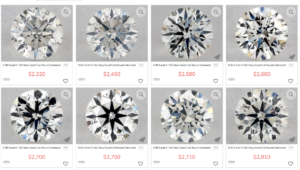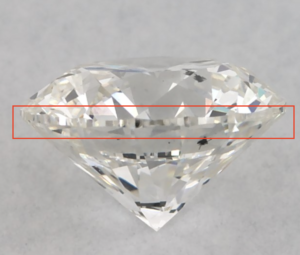
Diamond clarity refers to the presence of inclusions within a diamond.
These flaws develop as the diamond is formed under intense heat and pressure and have the potential to affect its durability, brilliance, and visible appearance.
At the top of the clarity scale are flawless (FL) diamonds, which have no inclusions visible at 10x magnification. I3 (included) diamonds earn the lowest grade.
SI (slightly included) diamonds are one level above Included and land below VS (very slightly included).

We’ll explore everything to know about SI diamonds, including:
- Common types of inclusions
- The difference between SI1 and SI2
- How much they cost
- Buying tips
- How to decide if it’s the right choice for you
What is an SI Diamond?
An SI diamond has small inclusions visible at 10x magnification. When gemologists are grading an SI diamond with a jewelers loupe, they won’t have to scan back and forth in order to spot the imperfections.
They’ll often be easily noticeable in multiple places on the diamond.
The most common types of inclusion in SI diamonds are:
- Clouds
- Feathers
- Pinpoints
- Twinning wisps
- Indented naturals
But this clarity grade isn’t referring to any particular type of inclusion. A few needle inclusions or a lack of clouds won’t designate it a specific clarity.
Instead, the grade denotes the overall impact the flaws have on its quality.
That means an SI diamond could have one occurrence of many different inclusions or one or two instances of the same one.
For example, this one-carat round cut diamond earned an SI1 clarity grade because of clouds, crystals, feathers, needles, indented naturals, and naturals.
As a comparison, this diamond earned the same clarity grade but has three types of inclusions.
This demonstrates how it’s not the number of flaws or any specific type that results in a certain clarity grade but instead how it affects the overall performance.
SI diamonds pass a diamond tester. The inclusions don’t indicate it was created in a lab.
SI1 vs. SI2 Clarity
There are two classifications of SI diamonds: SI1 and SI2.
The difference between them is the degree to which inclusions affect its appearance, durability, and light performance. The flaws in an SI1 diamond have less of an impact.
For example, some SI1 diamonds under one-carat are eye-clean, which means inclusions can only be seen with magnification.
This is a coveted trait because most buyers are only concerned with what the diamond looks like when viewed with the naked eye.
Larger diamonds require a higher clarity grade to be eye-clean, but ones less than one carat could be clean.
It’s rare for an SI2 diamond to not have visible inclusions, especially larger ones.
Unless you’re choosing small accents to complement the main diamond, you’ll likely see black specks, dark crystals, or feathers in this clarity grade.
To illustrate, here’s a side-by-side comparison of an SI1 and SI2 diamond.

On the right, its imperfections are more apparent.
SI1 diamonds are also less likely to have structural issues that could cause it to chip. The inclusions are often smaller or in positions that aren’t as vulnerable.
While SI1 diamonds could have inclusions on the table, SI2 diamonds may have inclusions near the crown or girdle.
Another difference between SI1 and SI2 diamonds is how the inclusions diminish brilliance. Dark imperfections in SI diamonds have the potential to interfere with how light reflects off the stone.
When light hits a black twinning wisp or a long feather, it can distort the way light travels through the diamond or cause it to leak out of the pavilion.
The heavier inclusions in an SI2 diamond can result in less brilliance, but cut is still a more important quality for light performance compared to clarity.
How Much Do SI Diamonds Cost?
Buyers are willing to pay a premium for fewer inclusions. All else being equal, SI diamonds are more expensive than ones that earn an I grade, but they cost less than VS diamonds and ones higher on the scale like VVS2, VVS1, FL, and internally flawless.
For most SI diamonds, you can expect to pay between $3,500-$5,000 for one carat, but its exact price is also dependent on its cut and color grade.
And within the SI classification, SI2 diamonds are less expensive than SI1.
The best way to understand the price changes for diamonds with different clarity grades is to compare gems that have all the same qualities except for clarity.
I compared diamonds from online jewelry vendor James Allen with the following qualities:
- Carat weight: 0.90
- Color: H
- Cut: Very good
For diamonds with those qualities and an SI1 clarity grade, the prices ranged from $3,150-$4,230. The average cost was $3,723.
For SI2 diamonds, the range was $2,320-$3,520, with an average of $3,067.

That’s a 21 percent increase in price for an SI1 diamond versus SI2.
At Blue Nile, you’ll see a similar pattern. One-carat diamonds with a very good cut, G color grade, and SI1 clarity start at $4,611.
Ones with the same qualities, except an SI2 clarity grade, begin at $3,829.
Buying Tips for SI Diamonds
1. Aim for Eye-Clean
Engagement ring diamonds should be eye-clean. You don’t want inclusions diminishing its quality by creating dark spots across its table.
That’s why most buyers start their search for an engagement ring with SI diamonds and then work up to VVS.
They offer exceptional value because you’ll avoid the premiums charged for higher clarity grades, but to the naked eye, you often won’t tell the difference.
For example, here’s an SI1 clarity diamond, but it’s difficult to identify any flaws, even in high-resolution.
I recommend starting your search for an eye-clean diamond at SI1, but don’t be surprised if you don’t find the right one and have to move up to VS1 or VS2.
When I was shopping for my now-wife’s engagement ring, I evaluated several in the SI range, but ended up choosing a VS1 diamond because it also had all the other qualities I wanted.
But if you find one at SI1 that’s eye-clean, you can put that savings toward higher grades in other categories.
It’s helpful to view your diamond in person before you buy it, but if you’re unable to do so, make sure you have access to high-resolution photos online.
Most of the top online diamond retailers provide these images, so buyers can have confidence without seeing it in person.
2. Avoid Inclusions That Affect Durability
Not all inclusions have equal impact. Some affect a diamond’s durability more than others.
You should avoid SI diamonds with these types of inclusions because it could chip. This is a more significant problem than visible dark spots or diminished brilliance.
For example, you shouldn’t buy an SI diamond that has heavy inclusions near an extremely thin girdle.

If it has a large feather or cavity in this area, it’s more vulnerable than one with pinpoints or crystals scattered across its table.
SI2 diamonds are more likely to have these inclusions to avoid. The inclusions are often larger, more noticeable, and in locations more susceptible to chipping.
You should also be mindful if the inclusions are near the pointed ends of fancy cuts.
Although you can hide imperfections with the prongs of its setting, placing too much pressure on a blemish could cause it to break.
If you choose an SI1 diamond, you shouldn’t worry too much about its durability.
3. Examine the Grading Report
You should only buy a diamond that’s been graded by a credible organization.
Most reputable diamond vendors include a report from one of these organizations with each diamond. For example, James Allen sells GIA and IGI diamonds.
Blue Nile has diamonds graded by the GIA and certified by GCAL.
I recommend always reading the diamond grading report on SI diamonds so you know why it was given that grade.
For example, this one-carat, SI1 diamond from Brilliant Earth includes a GIA report.

You can see on the clarity characteristics plot it was given an SI1 grade because of three types of inclusions.
All are on the diamond’s table and some are close together in the middle.
The inclusions are also visible from the top-down view, as opposed to the pavilion view.
This means if the diamond isn’t eye-clean, they’re more noticeable when you’re wearing the ring.
If they’re only visible from the pavilion, it’ll likely earn a higher clarity grade.
You can also learn more about the clarity of SI diamonds in the “Additional Grading Information” section of the GIA report.

You’ll learn if there’s surface graining on the diamond, whether it has issues with symmetry or polish, and how it fluoresces under light.
These factors are all taken into consideration to assess the diamond’s overall quality.
Should You Choose an SI Diamond?
SI diamonds are a popular choice because they’re affordable and can look similar to diamonds with higher clarity unless viewed with magnification.
If you’re considering whether an SI1 or SI2 diamond is right for you, here are some guidelines to help you decide.
Consider an SI diamond if:
- The diamond is less than 1.5 carats
- You’ve had a chance to view it in person or through high-resolution photos and know the inclusions aren’t visible
- You want to avoid the premiums charged for diamonds with a higher clarity grade so you can put that savings toward other qualities
By pairing an SI diamond with unique settings, you can land on the perfect ring for you.

Jacob Clarke
Jacob Clarke is the founder of TeachJewelry.com.
He earned an Applied Jewelry Professional Diploma from the Gemological Institute of America (GIA) and now brings you essential information about diamonds, settings, and more.
Jacob has consulted with leading jewelry brands, and his work has been cited in Clean Origin, Diamond Nexus and industry publications.
He's also a member of the International Gem Society.
He enjoys discussing jewelry with readers, so contact him with any questions at jacob.clarke@teachjewelry.com.















